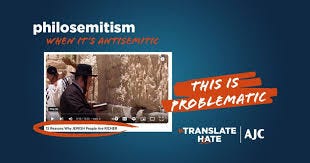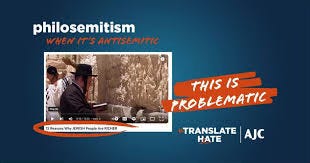No Need for Special Protections
IHRA Antisemitism Definition Distorts History and Employs History Anti-Jewish Trope
The ADL — the Anti-Defamation League — has a long and complicated history. While it occasionally has found itself on what I would call the “right side” of issues (it supported the DREAM Act for undocumented minors), more often than not its leadership swims in a reactionary swamp poisoned by racism and Islamophobia.
Its unequivocal support for Israel, even as Israel maintains a violent occupation of the West Bank and Gaza that it has ramped up into a full-scale demolition and cleansing of Gaza, only makes sense if you assume that the 2.2 million people who were living in Gaza on Oct. 7 were collectively responsible for the violent incursion into Israel proper by Hamas. It is only possible if you refuse to acknowledge the humanity of 2.2 million Gazans, if you essentialize them, compress them into a single entity.
This is the definition of racism, to assume that entire racial or ethnic groups share and are governed by a common characteristic or set of characteristics, to erase the individuality of members of these groups, and to then act on these beliefs. In the American racial context, as Ibram X. Kendi demonstrated in Stamped from the Beginning: The Definitive History of Racist Ideas in America, this both grows and has resulted from the enslavement of Africans, segregation and Jim Crow, the American wars on drugs and crime.
“The principal (sic) function of racist ideas in American history has been the suppression of resistance to racial discrimination and its resulting racial disparities,” Kendi writes.1
The beneficiaries of slavery, segregation, and mass incarceration have produced racist ideas of Black people being best suited for or deserving of the confines of slavery, segregation, or the jail cell. Consumers of these racist ideas have been led to believe there is something wrong with Black people, and not the policies that have enslaved, oppressed, and confined so many Black people. (10)
Substitute “Palestinian,” “Muslim,” “Arab” — or “Jew” for that matter2 — and it seems pretty clear why our discourse about the Middle East is so distorted. Jews get the benefit of the doubt in the United States because we are viewed as white (even if this whiteness is conditional to a degree), and because we have been assigned the “model minority” label for several decades (after being tarred as Communist infiltrators or religious others in earlier decades). Attaching the model minority label to Jews is philosemitism, which is still a form of antisemitism because it treats Jews as a class and not as individuals.
Muslims, as a broad class in this narrative, are cast as the non-white other, invaders, dangers. They are the photo negative of the good Jew and deserving of the kind of restrictions Donald Trump sought to impose during his presidency.
On Monday, a New Jersey State Senate committee heard public comment and testimony on a bill that would inscribe into law a definition of antisemitism, along with specific examples, that would make criticism of Israel a violation. There is an urgency to pass the bill, though a similar bill that would codify a definition of Islamophobia has failed to move forward.
The two main faculty unions at Rutgers — including the adjunct union on whose executive board I serve — issued a pointed joint statement criticizing S1292 and A2937, because it “falsely conflates criticism of or opposition to Israel and Zionism with anti-Jewish racism,” and limit academic freedom and free speech in the state.
In response, the union received a note from a member with a link to a column by Jonathan Greenblatt of the ADL that attempts to paint criticism of Israel as a “bigotry of no expectations” — a bastardization of a line from President George W. Bush’s first election campaign, a line meant to undermine support for affirmative action and to pretend that an equality of access actually existed.
The column — posted to the Times of Israel — traffics in the same stereotypes I mention above, even recycling Bush’s racial sleight of hand to dress up what is little more than a racist argument.
Greenblatt argues that Palestinians are held to a lower standard, that there are “no expectations” that they behave in humane ways, that “world leaders, commentators and protesters in the street have zero expectations for moral, ethical behavior for Hamas and those supporting them in the streets of Gaza or in the streets of cities around the world.” He says we — I am a commentator and protester — “assign no agency to Gazans, relegating them to the role of perpetual victim – a soft bigotry – while at the same time, seeing Israel and the Jewish people as eternally evil – a hard bigotry to be sure.”
He points to the use of human shields (both the hostages and Palestinian civilians) and cherry-picked slogans and incidents of support for Hamas on college campuses to create a sense of imbalance. The “soft bigotry” applied to Palestinians and the “hard bigotry” allowed when discussing Israel.
It’s a convenient, if totally disingenuous, argument, and it ignores just how closely allied the American government is with the Israeli government, how much money and weaponry it supplies, and the indiscriminate violence being perpetrated by the Israeli military on a 139-square-mile strip of land. Greenblatt makes no mention of the 40,000 men, women, and children killed by Israel in response to Oct. 7. Instead, he tells Palestinians — as Bush told African Americans — you are being held back by low expectations. His argument essentially is they can do better and will if we hold them to higher standards.
Greenblatt’s argument — just like Bush’s — is meant to ncidents of argument applies equally to his tolerance of Israeli violence, which he barely mentions, asking of Palestinians what he fails to ask of Israel in its waging of war against the people of the Gaza Strip. Greenblatt’s argument underscores the racism that is central to all nationalist agendas, a racism baked in because nationalism — whether Christian, Hindu, Muslim, or Jewish — is tribal in nature and erases the humanity of those it considers outside the tribe.
This tribal mindset is central to the definition of antisemitism being considered by the New Jersey Legislature and passed by more than 35 states. The bills would codify the working definition endorsed by the International Holocaust Remembrance Association, are supported by many Jewish groups — even though its original author now criticizes the definition as a danger to free speech.
The IHRA definition itself, is somewhat milquetoast:
Antisemitism is a certain perception of Jews, which may be expressed as hatred toward Jews. Rhetorical and physical manifestations of antisemitism are directed toward Jewish or non-Jewish individuals and/or their property, toward Jewish community institutions and religious facilities.
Actions that stem from “a certain perception of Jews” as a people, a unity, are antisemitic, especially when they express themselves in “physical manifestation.” The appended examples, however, include several references to Israel that are at best debatable, though couched again in seemingly benign language. Jewish self-determination is held up as an undeniable right of the Jewish people — but not as a corollary right for Palestinians — and that criticism of “the existence of a State of Israel is a racist endeavor,” a pairing that both justifies a race-based occupation of Palestinians by the Israeli government and erases the explicitly racist assumptions that underpinned the forced expulsion of Palestinians from their homes over the course of the first half of the 20th Century leading up to the declaration of Israeli statehood.
This history is both complicated and contested. It is weighed down with a level emotion that makes it hard for either side to view the other as fully human or deserving of a hearing. It has prevented real discussions about solutions — even Oslo was marred by a sense among a large number of Palestinians that they were not included, while the Israeli settler movement and right wing make it clear they will accept nothing short of a Greater Israel “from the river to the sea.”
The IHRA definition ignores the various disagreements — whether inter-religious and inter-ethnic or within the Jewish community. It replaces the contested histories of Israel/Palestine with a single narrative that erases the history of Arab Palestine and accepts the mythology of a vacant land reclaimed and ultimately revitalized by the Zionist Jews.
The reality is more complicated, as is the question of what qualifies as antisemitism, and whether the IHRA definition, by essentializing Jews, by eliding our disagreements, our individuality, and setting us up as special, is guilty of fostering a dangerous philosemitism, of setting us up as a powerful minority — which is one of the oldest anti-Jewish tropes in the world.
Kendi, Ibram X. Stamped from the Beginning: The Definitive History of Racist Ideas in America, 2016, Nation Books, p. 10.
Substitute “Mexican” or “migrant” and this can help explain the current immigration debate.





